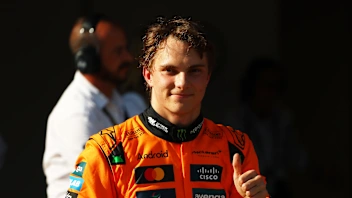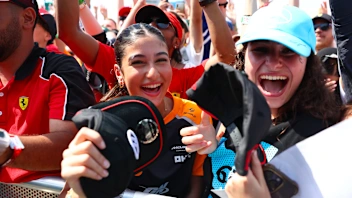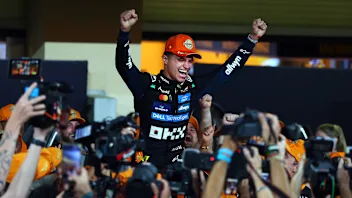The word ‘porpoising’ is back in fashion in F1, having been largely missing from the vocabulary for the last 40 years – when we last had ground effect cars...
Virtually every team was complaining of the phenomenon on the first day of running for the new generation of cars.
A violent bouncing on the suspension at high speeds is what the driver feels. The cause is an aerodynamic one, where either the leading edge of the floor, or perhaps the front wing, is pushed ever closer to the ground as the downforce acting upon it increases. The closer to the ground it gets, the more powerful the ground effect is, as the air rushes ever-faster through the shrinking gap.
READ MORE: 5 things we learned from Day 1 of pre-season running in Barcelona
This increases the pressure difference between the underside and upper surfaces, so increasing the downforce yet more – until it stalls. At which point, much of the load is suddenly released, the front of the car rises up suddenly in response – which allows the ground effect to begin working again! Repeat in cyclic fashion until it’s time to brake for the corner...
With much more underbody downforce, stiffer suspensions and stiffer tyres (so not as much cushioning effect) the problem has returned with a vengeance. None of the teams had seen this effect in simulation. In a wind tunnel, even the stiffest belt of the rolling road is more flexible than the track surface, and accurately modelling the dynamics of the springs and dampers in this situation is not really possible.
READ MORE: Bottas bemoans 'compromised' first day of pre-season running with Alfa Romeo
So, the teams are now back in the same position as the early ground effect pioneers of the late 1970s/early 1980s of trying to make the underside of the car a little less switch-like and critical – either through changing the shape of the surfaces or adjusting the suspension.
Ironically, the hydraulic tricks of the suspensions which have just been banned would have been very useful in this…
Watching how the teams cope with this unforeseen demand will be fascinating. But cope with it they surely will.
Next Up
Related Articles
 Piastri reveals lessons that will ‘only make me stronger’
Piastri reveals lessons that will ‘only make me stronger’.webp) Winners & Losers5 Winners and 5 Losers from the 2025 season
Winners & Losers5 Winners and 5 Losers from the 2025 season Celebrating the first F1 Allwyn Global Community Awards
Celebrating the first F1 Allwyn Global Community Awards Formula 1’s record-breaking 2025 season in numbers
Formula 1’s record-breaking 2025 season in numbers UnlockedQUIZ: 10 questions on the new World Champion Lando Norris
UnlockedQUIZ: 10 questions on the new World Champion Lando Norris Verstappen confirms new number for 2026 season
Verstappen confirms new number for 2026 season
